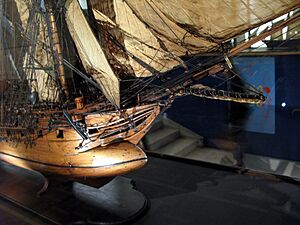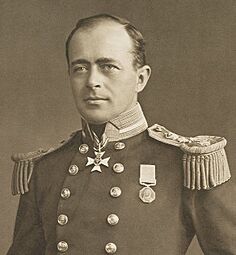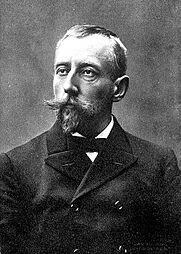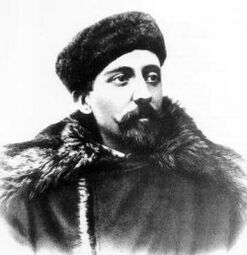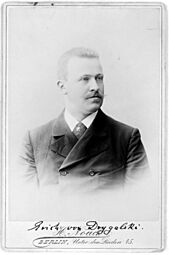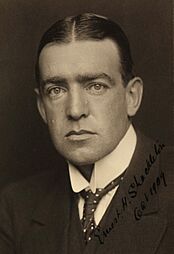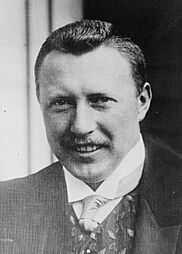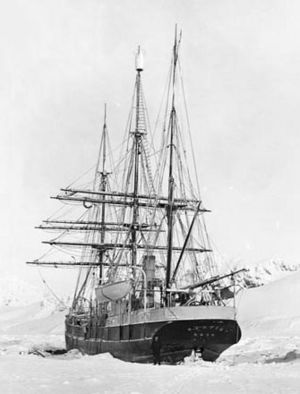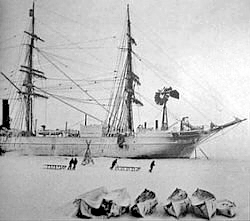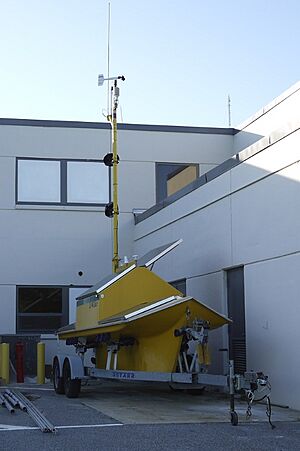History of research ships facts for kids
A research ship is like a floating laboratory! These special ships explore the oceans, helping scientists learn about the Earth's waters, weather, and the amazing creatures living deep below. They have been around for a long time.
One of the earliest research ships was James Cook's Endeavour. In 1766, the Royal Society hired Cook to sail to the Pacific Ocean. His main job was to watch and record the transit of Venus across the Sun. The Endeavour was a strong ship, ready for tough journeys. It had special areas for scientists like Joseph Banks to do their work. The Endeavour also did other research, like mapping the ocean floor.
Other famous early research ships include HMS Beagle, RV Calypso, HMS Challenger, and the Endurance and Terra Nova.
Contents
Exploring the Poles: A Great Race
19th Century Expeditions
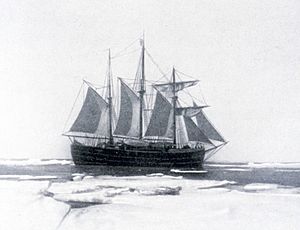
In the late 1800s, many countries wanted to explore the North and South Poles. It was like a big race! Ships from Russia, Great Britain, Germany, and Sweden set out to study the Arctic Ocean.
Some ships faced tough challenges. The Hansa was crushed by ice and sank. The Tegetthoff and the Polaris also met the same fate. But others were more successful. The Royal Navy ships Alert and Discovery brought back many important observations from the Arctic.
A huge achievement was Adolf Erik Nordenskiöld's discovery of the Northeast Passage. His ship, the Vega, was the first to sail all the way around Eurasia.
Nansen's Amazing Idea Fridtjof Nansen had a brilliant idea for exploring the Arctic. He heard that parts of an American ship, the Jeanette, which sank near Siberia, were later found off Greenland. This made Nansen think there must be a strong ocean current flowing across the Arctic. He planned to build a special ship, the Fram, and let it freeze into the ice. He believed the current would carry the ship safely across the Arctic Ocean, maybe even to the North Pole!
The Fram was built to withstand the crushing ice. Nansen's theory about the currents was proven right, even though he didn't reach the exact North Pole himself. The Fram collected lots of data on ocean depth, weather, and Earth's magnetic field.
First to Overwinter in Antarctica While Nansen was in the Arctic, his countryman Roald Amundsen headed to the Antarctic. He joined the Belgian Antarctic Expedition aboard the Belgica. The Belgica was originally a whale-hunting ship. It was changed to include a laboratory and extra cabins for scientists. Between 1887 and 1899, the Belgica became the first ship to spend a winter trapped in the Antarctic ice. Scientists on board studied biology and physics.
20th Century Adventures
In the early 1900s, the race to the South Pole continued. Germany built the Gauss, a strong ship designed like the Fram to survive ice pressure. It explored the southern Indian Ocean. The Swedish expedition used the old ship Antarctic, but it sadly sank in 1902. Luckily, everyone was rescued!
Great Britain built the Discovery for Robert Falcon Scott's expedition. This ship also got stuck in the ice. Other ships, the Morning and Terra Nova, had to help free it.
The Scotia was another important ship, used by a Scottish expedition. It was originally a whale catcher, but it was repaired and given a new engine for research. The Scotia was very successful, collecting samples from deep in the Weddell Sea.
French explorer Jean-Baptiste Charcot sailed the Français and later the Pourquoi Pas to the Antarctic. He even helped rescue Amundsen later on.
The Race to the South Pole Sir Ernest Shackleton tried to reach the South Pole with his ship, the Nimrod. He got very close but had to turn back. Another German expedition used the ship Deutschland, which made important discoveries about the Atlantic Ocean and Weddell Sea.
The years 1910-1912 saw the famous "great race" between Roald Amundsen and Robert Falcon Scott to be the first to reach the South Pole. Amundsen used the reliable Fram. Scott sailed on the Terra Nova. Amundsen won the race.
Australia also sent its first expedition ship, the Aurora, to the Antarctic. It even carried an early airplane, though it wasn't very useful. The attempt to cross Antarctica by Shackleton (on the Endurance) and Mawson (on the Aurora) was one of the last big expeditions before World War I.
Between the World Wars
After World War I, ocean research started up again. A big invention was the echo sounder in 1912. This device uses sound waves to measure the distance to the seabed. Before, ships had to use long wires and weights! Warships used echo sounders during the war.
The German ship Meteor was the first to use the echo sounder for science in the 1920s. It systematically mapped the Atlantic Ocean, taking 67,000 soundings! This helped cartographers create much better depth maps.
Other ships, like the American Carnegie and the Dutch Willebrord Snellius, also mapped different oceans. The British ships William Scoresby and Discovery II explored around Antarctica.
Danish scientists focused on marine biology, studying fish and plankton. The Dana Expedition collected a huge number of marine species. Another expedition, the Mabahiss, explored the Red Sea, Indian Ocean, and Gulf of Oman, covering over 41,000 km!
In the 1930s, countries started working together more on marine research. For example, the German Altair and Norwegian Armauer Hansen worked together to study the Gulf Stream. Even flying boats were used for research! The Boreas and Passat were carried on the ship Schwabenland to take aerial photos of Antarctica.
During World War II, ocean research mainly focused on military needs. Scientists studied underwater sound for submarines and waves for landing troops.
After World War II
After World War II, many countries, especially the United States, greatly increased their ocean research. Two smaller countries had very important expeditions:
- The Swedish "Albatross" expedition (1947-1948) crossed the equator 18 times and collected over 200 core samples from the seabed.
- The second Danish "Galathea" expedition (1950-1951) focused on deep-sea life. They successfully caught live animals from the bottom of the Philippine Trench, proving that life can exist in the deepest parts of the ocean! They also found a "living fossil" called Neopilina galathea.
Scientists also began using seismic refraction methods, which use sound waves to study the Earth's crust. This, along with palaeomagnetic research (studying Earth's ancient magnetic field), helped scientists understand Alfred Wegener's continental drift theory and the development of plate tectonics.
Working Together: International Collaboration
In the 1950s, countries started working together even more closely on ocean research. The NOPAC project involved Canadian, American, and Japanese ships all working together.
A huge step was the International Geophysical Year (IGY) in 1957-1958. Sixty research ships from forty nations worked together to explore deep-sea currents. For the first time, the Soviet Union also joined an international project, using their large research ships like Vityaz and Michail Lomonosov. The IGY marked a new era of international teamwork in marine research.
Another program, "Overflow," involved nine research ships from five European countries. They studied how cold Arctic water flows over underwater ridges. This program was later repeated on an even larger scale with thirteen ships from seven countries!
Tropical Weather Studies
Between 1959 and 1965, forty research ships from 23 countries worked together to study the Indian Ocean. This ocean was less known, partly because of its unique monsoon weather patterns. The goal was to help developing countries around the Indian Ocean start their own sea and fishing research programs.
Later, the Global Atmospheric Research Programme (GARP) called for a global weather experiment. More than fifty ships worked in equatorial areas around the world. They collected huge amounts of data on the ocean and atmosphere to create an "inventory of the world weather."
As the need for raw materials grew, more and more countries joined in marine research.
China's Research Ships
Between 1964 and 1975, China built forty research ships. These included the Practice and the Xiang Yang Hong 5, which was China's first multi-purpose research ship. At first, China often changed fishing boats or old navy ships into research vessels. But in the 1970s, they began building new, larger ships like the Xiang Yang Hong 10.
By 1984, China's research fleet had 165 ships! Most were run by the national oceanography bureau, oil departments, agriculture departments, and universities. In 1984-1985, the Xiang Yang Hong 10 and J 121 were the first Chinese research ships to sail to the Antarctic. They helped build China's "Great Wall" research station there. China quickly caught up in marine research and aimed to have a voice in the future of Antarctica.
Autonomous Research Vessels
Imagine a research ship that sails itself! These are called autonomous research vessels. They are like robots that can explore the ocean without people on board. At first, these vehicles were mostly used in rivers, lakes, and bays because navigating in the open ocean was tricky.
But with new technology like better navigation systems and smart sensors, autonomous vessels are becoming more common. They are helping scientists explore even more of our amazing oceans.
See also
- Research vessel
- Heroic Age of Antarctic Exploration
- List of Arctic expeditions
- List of Antarctic expeditions



